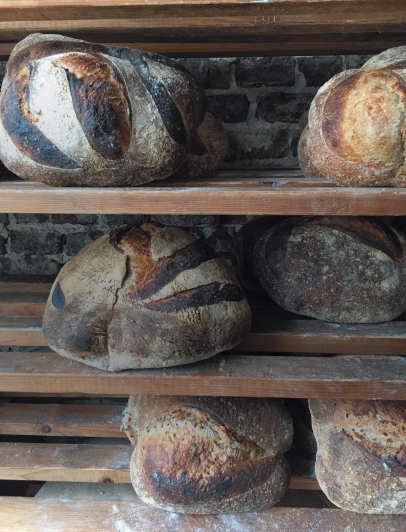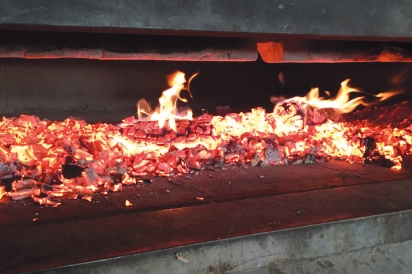Baking Takes Us Back In Time
Transforming grains connects us to our past, present and future
Baking takes place in a space where time moves slowly enough that I can track it. During the Industrial Revolution, the goal was to scale and speed things up. While technology, apps and conveniences assist us in doing more in less time, baking connects us to a place where we can buy back time. We see a resurgence of baking with natural fermentation, breads leavened without the assistance of commercial yeast. Bakers continue the tradition of sharing their notes on developing protein structure (mixing by hand, mixing minimally with machine, use of folds) and knowledge of dough pH and enzymatic activity.
I’ve traveled the world baking. Working with my hands has provided the opportunity to step out of an established routine and experience something that is oftentimes vastly incomparable. I find myself in places where I don’t know anyone (yet) and end up spending a lot of time with myself. Over the years, I’ve learned to become more observant, nudged by the moments of not being able to converse well in the local language.
I’ve noticed that many cultures have a flatbread or pancake, a crisp bread or cracker, a porridge made from grains or soaked old bread, a filled or stuffed bread or pastry, and a use for yesterday’s bake. Yet what is produced in the bake room differs everywhere. It varies by culture, relationship to the land, style of oven and access to the grains that grow best in the local soils. Even terroir comes into play.
I remember moments when I could taste the differences from one plot to another. When I baked at Meyers Bageri in Copenhagen, Denmark, in 2009, most of the bread formulas (recipes) were identical except for the variety of grain or where that grain was grown. The varying taste and color of the final loaves or rolls were noticeable. I would eat comparable rolls each day to identify subtle flavors. At that time, I was drawn to the sweet nuttiness of the Ølands wheat. At another time and place, the head baker at De Superette in Gent, Belgium, focused on blending the wind-powered-milled grains, with an eye toward how much germ and bran were present in the flour (known as extraction levels). Over the past decade, there has been an increased awareness of heritage, landrace and heirloom varieties of grains and extraction levels by both commercial and home bakers.
In our quest for diversity, including in agriculture and baking, perhaps we can reconsider our expectations as farmers, millers, bakers and consumers. When our palates expand, we support lesser-known grains, demand variety in planting and preparation and support ancestral approaches to groundedness that are rooted in landrace and localized grains. For centuries, plant breeding has been used to increase food production by developing disease- and stress-resistant, high-yielding and early-maturing grain varieties. However, for a sustainable food future, it is essential to have a stable and wide pool of grain genotypes grown under varying environmental conditions for continued adaptability. With these approaches, recipes will become more like guidelines as micro adjustments will be necessary to adapt to regional grain characteristics.
My family is from a region of China where steamers are more the norm than ovens. There, grains such as rice and millet were often steamed, or, 蒸 “jing.” Tall stacks of bamboo steamers sit atop a pot of boiling water. Shuffling the stack of steamers reminds me of moving bread around the oven deck during baking to distribute heat more evenly, since ovens can develop hot and cold spots.
Ovens have a capacity to hold heat once hot. Because it takes quite a bit of energy to heat up an oven, oven builders gave much thought to thermal mass capacity and passed this knowledge to willing generations. Bakers learned to bake (and cook) a range of products to efficiently use the varying temperatures as the oven cools.
Living in small spaces can tune us to the heat an oven emanates. In a studio apartment, turning on the oven reinforces the unbearable summer heat long after the oven has been turned off. The weather dictates whether I bake with the oven or make flatbreads on a skillet. When I decide to use the oven, I don’t just bake a small roll for myself, but a tray of rolls or a loaf or two of bread to share. As the oven cools, I may make cookies or crackers, perhaps even dry some herbs or dehydrate seed crackers as the oven temperature drops further. The heating and cooling of the oven shows that baking is a creative practice in which every moment opens a new opportunity.
Baking can ground us to a place. The fewer ingredients, the more local the ingredients can be. Bread can be made with just flour, water, salt and the microbes in a baker’s kitchen. Living in Texas, we have access to grain-growing regions and a gulf where salt can be harvested. Our climate affects how various grains will grow. A variety of grain grown in Washington will yield and perform differently in Texas. These differences will be apparent in the dough—make the flour thirstier, the protein bonds stronger, or not.
A shared recipe offers insight into the ratios for these ingredients. But when we mix bread by feel, the baker—not the recipe—controls the dough’s destiny. Those guidelines could have been created with a different variety of grain (or blend of grains) and baked in a different environment, which could lead to a different loaf. The repetition of hands-on practice allows us to find the range of feeling, of magic, in the dough.
It’s the duality of simplicity and complexity that keeps me attracted to baking. Baking is not as simple as following a series of guided steps. It requires some level of precision, but more than anything it’s an intangible sensitivity to the wonders of fermentation, resources, environment and practice. Working dough with our hands can be a medium for allowing something else to dictate how we measure time. Baking is a personal experience that connects us through ancestral traditions and techniques to other bakers and to time and place.






